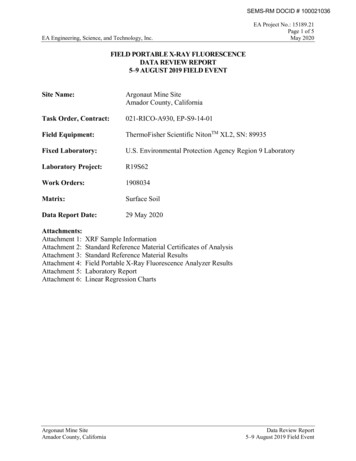
Transcription
SEMS-RM DOCID # 100021036EA Project No.: 15189.21Page 1 of 5May 2020EA Engineering, Science, and Technology, Inc.FIELD PORTABLE X-RAY FLUORESCENCEDATA REVIEW REPORT5–9 AUGUST 2019 FIELD EVENTSite Name:Argonaut Mine SiteAmador County, CaliforniaTask Order, Contract:021-RICO-A930, EP-S9-14-01Field Equipment:ThermoFisher Scientific NitonTM XL2, SN: 89935Fixed Laboratory:U.S. Environmental Protection Agency Region 9 LaboratoryLaboratory Project:R19S62Work Orders:1908034Matrix:Surface SoilData Report Date:29 May 2020Attachments:Attachment 1:Attachment 2:Attachment 3:Attachment 4:Attachment 5:Attachment 6:XRF Sample InformationStandard Reference Material Certificates of AnalysisStandard Reference Material ResultsField Portable X-Ray Fluorescence Analyzer ResultsLaboratory ReportLinear Regression ChartsArgonaut Mine SiteAmador County, CaliforniaData Review Report5–9 August 2019 Field Event
EA Engineering, Science, and Technology, Inc.1.EA Project No.: 15189.21Page 2 of 5May 2020IntroductionThe 5–9 August 2019 field investigation at the Argonaut Mine Site included collection of 40 soilsamples for determination of metals content via field portable x-ray fluorescence (XRF)analyzer. The analyzer used was a field portable ThermoFisher Scientific NitonTM XL2. Eachsample was typically only scanned once with the analyzer. However, on occasion, samples werescanned multiple times and results were averaged. Scans of samples identified as “screen” bythe sampling crew were collected for the purposes of field information only and are not includedin the data processing discussed in this report. The “screen” samples were either not sieved, notdried, or not processed according to EA Engineering, Science, and Technology, Inc.’s (EA’s)XRF Standard Operating Procedure (SOP; EA 2018). A complete list of soil samples collected,not including screening samples, and the analyzer used for metals content determination areincluded in Attachment 1.Quality control tests were performed to ensure the accuracy and reproducibility of collected data,and to ensure the data were consistent with the manufacturer’s specifications and projectrequirements as specified in the Sampling and Analysis Plan (SAP; EA 2019). Prior to arrivingonsite, the XRF analyzer was calibrated at the factory. At the site, system checks, standardreference material (SRM) tests, and blank tests were performed, generally, at the beginning,middle, and end of workday, and each time an instrument battery failed or was replaced.2.Standard Reference MaterialsThe following four SRMs were used during this event: Standard Reference Material 2709a: San Joaquin SoilStandard Reference Material 2780a: Hard Mine Rock WasteStandard Reference Material 2782: Industrial SludgeSdAR-M2: Metal-Rich SedimentTill-4.Certificates of analysis for each SRM are presented in Attachment 2. The relative percentdifferences (RPDs) between field analyzer XRF readings of the SRM and results presented in thecertificates of analysis are presented in Attachment 3. For this event, the RPD for arsenic,copper, lead, rubidium, strontium, zinc, and zirconium met the criteria of being within 20 percent(EA 2019) more than 84 percent of the time.3.X-Ray Fluorescence Data ProcessingAs discussed above, on occasion, multiple XRF readings were recorded for each sample. Thearithmetic mean of the XRF readings for each sample was then calculated to obtain a single,averaged, concentration value for each analyte per sample. XRF readings that were below thelimit of detection ( LOD) were omitted from the averages. The XRF result or calculated meanvalue for each analyte and sample are presented in Attachment 4.Argonaut Mine SiteAmador County, CaliforniaData Review Report5–9 August 2019 Field Event
EA Engineering, Science, and Technology, Inc.4.EA Project No.: 15189.21Page 3 of 5May 2020Fixed Laboratory Data SummaryA total of 18 soil samples were submitted to the U.S. Environmental Protection Agency(EPA) Region 9 Laboratory in Richmond, California for metals analysis for the purposes ofcomparison with XRF results. Aliquots of two soil samples were sent as blind duplicates to thelaboratory. Laboratory samples scheduled for metals analysis were processed per thelaboratory’s SOP 503, Determination of Trace Elements in Solids and Leachate ProcedureExtracts by ICP-AES (EPA 2014) which is based on EPA Method 6010C, Inductively CoupledPlasma – Atomic Emission Spectrometry, Revision 3, February 2007 (EPA 2007a). Sampleswere also analyzed for mercury per the laboratory’s SOP 517, Analysis of Solid Samples forMercury (EPA 2018a) which is based on EPA Method 7471B, Mercury in Solid or SemisolidWaste (Manual Cold-Vapor Technique), Revision 2, February 2007 (EPA 2007b), or per thelaboratory’s SOP 535, Analysis of Mercury in Solids by Thermal Decomposition and AAS(EPA 2018b) which is based on EPA Method 7473, Mercury in Solids and Solutions by ThermalDecomposition, Amalgamation, and Atomic Adsorption Spectrophotometry, Revision 0,February 2007 (EPA 2007c). Samples with mercury concentrations exceeding 42.5 milligramsper kilogram wet weight are generally not amenable to analysis per SOP 535, and thus areanalyzed per SOP 517. Attachment 5 provides the complete fixed laboratory analytical reports.Table 1 presents the analytical precision evaluation of the parent and duplicate laboratorysamples. All RPDs meet the measurement performance criteria of less than 50 percent asestablished in the SAP (EA 2017).5.Comparison of X-ray Fluorescence Results with Fixed Laboratory ResultsData collected with the XRF analyzer were compared to the fixed laboratory results to determinethe usability of the XRF-based data. A linear regression analysis of the two data sets wasconducted and, based on the results, the XRF data were classified as being potentially usable asdefinitive level data, screening level data, or not usable.The linear regression analysis was performed for 11 metal analytes. The results are presented onTable 2. The analysis was not performed on the remaining analytes because either the samplesize was too small (n 5), or the results were reported in one data set but not in the other (e.g.titanium was reported by the XRF analyzer but not by the fixed laboratory). Table 2 lists theanalytes that were omitted from the linear regression analyses and the reason for their omission.The linear regression analysis estimates a best-fit line for paired results for each analyte which, ifboth data sets were identical, would have a slope of one, a y-intercept of zero, and a correlationcoefficient of one. The correlation coefficient, in this context, measures the similarity betweenthe two data sets. The closer the correlation coefficient is to one, the more similar the two datasets are and the better the comparability. If the results for an analyte spanned more than oneorder of magnitude, then the regression analysis was performed on log transformed concentrationvalues (EPA 2007d). A linear regression analysis was only performed on data sets with a samplesize greater than or equal to five.Argonaut Mine SiteAmador County, CaliforniaData Review Report5–9 August 2019 Field Event
EA Engineering, Science, and Technology, Inc.6.EA Project No.: 15189.21Page 4 of 5May 2020X-Ray Fluorescence Data Use RecommendationsThe usability of the XRF results was determined by comparing the correlation coefficientcalculated for each analyte to the thresholds set for screening level data and definitive level datain Method 6200 - Field Portable X-Ray Fluorescence Spectrometry for the Determination ofElemental Concentrations in Soil and Sediment (EPA 2007d). If the correlation coefficient isgreater than 0.7, then the XRF-based results for that analyte can be considered as screening leveldata. If the correlation coefficient is greater than 0.9, then the results can be considered asdefinitive level data.Table 2 summarizes the linear regression results and the usability recommendations. The linearregression results are presented in graph form in Attachment 6. A summary of the data usabilityrecommendations is provided below.Definitive Level Analytes: arsenic and lead.Screening Level Analytes: copper, manganese, strontium, and zinc.XRF Not Recommended for Use: barium, cobalt, chromium, iron, and mercury.No Regression Performed: silver, cadmium, nickel, antimony, selenium, aluminum, boron,beryllium, calcium, potassium, magnesium, molybdenum, sodium, thallium, vanadium, gold,palladium, rubidium, scandium, tin, titanium, tungsten, and zirconium.Note, mercury is identified in Table 2 as passing criteria that would allow it to be used as adefinitive level data. However, only five samples were included in the regression which is theminimum number of samples able to be regressed. Four mercury results were measured between4.67 to 5.6 milligrams per kilogram (mg/kg) and one mercury result was 45 mg/kg. Theregression is skewed by the high outlier; thus, the regression is highly uncertain.Argonaut Mine SiteAmador County, CaliforniaData Review Report5–9 August 2019 Field Event
EA Engineering, Science, and Technology, Inc.7.EA Project No.: 15189.21Page 5 of 5May 2020ReferencesEA Engineering Science and Technology, Inc. (EA). 2017. Sampling and Analysis Plan,Remedial Investigation, Argonaut Mine, Amador County, California, Revision 00.January.———. 2018. Standard Operating Procedure No. 056 for X-Ray Fluorescence Analysis of Soil.Revision 1. January.———. 2019. Sampling and Analysis Plan, Remedial Investigation, Argonaut Mine, AmadorCounty, California, Revision 01. February.U.S. Environmental Protection Agency. 2007a. Method 6010C, Revision 3, Inductively CoupledPlasma – Atomic Emission Spectrometry: Final Update IV to the Third Edition of theTest Methods for Evaluating Solid Waste, Physical/Chemical Methods, EPA publicationSW‐846 Office of Solid Waste and Emergency Response. February.———. 2007b. Method 7471B, Revision 2, Mercury in Solid or Semisolid Waste (ManualCold-Vapor Technique), Final Update IV to the Third Edition of the Test Methods forEvaluating Solid Waste, Physical/Chemical Methods, EPA publication SW‐846 Office ofSolid Waste and Emergency Response. February.———. 2007c. Method 7473, Revision 0, Mercury in Solids and Solutions by ThermalDecomposition, Amalgamation, and Atomic Adsorption Spectrophotometry, FinalUpdate IV to the Third Edition of the Test Methods for Evaluating Solid Waste,Physical/Chemical Methods, EPA publication SW‐846 Office of Solid Waste andEmergency Response. February.———. 2007d. Method 6200, Revision 0, Field Portable X-Ray Fluorescence Spectrometry forthe Determination of Elemental Concentrations in Soil and Sediment, Final Update IVto the Third Edition of the Test Methods for Evaluating Solid Waste, Physical/ChemicalMethods, EPA publication SW‐846 Office of Solid Waste and Emergency Response.February.———. 2014. Standard Operating Procedure 503, Determination of Trace Elements in Solidsand Leachate Procedure Extracts by ICP-AES. Revision 6. Effective Date: 18December 2014. USEPA Region 9 Laboratory, Richmond, California.———. 2018a. Standard Operating Procedure 517, Analysis of Solid Samples for Mercury.Revision 6. Effective Date: 24 July 2018. USEPA Region 9 Laboratory, Richmond,California.———. 2018b. Standard Operating Procedure 535, Analysis of Mercury in Solids by ThermalDecomposition and AAS, Revision 5. Effective Date: 21 December 2018. USEPARegion 9 Laboratory, Richmond, California.Argonaut Mine SiteAmador County, CaliforniaData Review Report5–9 August 2019 Field Event
This page intentionally left blank
Tables
This page intentionally left blank
EA Project No.: 15189.21Revision: 00Table 1; Page 1 of 2May 2020EA Engineering, Science, and Technology, Inc.Table 1 Analytical Precision Evaluation of Parent and Duplicate SamplesParent Sample Duplicate 5-6SB-96-5-6Argonaut MineAmador County, neseMercuryParentDuplicateConcentration Parent Concentration 10%0%5%15%0%4%-11%-3%1%0%0%1%0%10%9%2%Data Review Report5-9 August 2019 Field Event
EA Project No.: 15189.21Revision: 00Table 1; Page 2 of 2May 2020EA Engineering, Science, and Technology, Inc.Table 1 Analytical Precision Evaluation of Parent and Duplicate SamplesParent Sample Duplicate ion Parent Concentration %Notes:No RPD was calculated if either the parent or duplicate sample concentration was ND.mg/kg - milligrams per kilogramND - nondetectJ - the reported result for this analyte should be considered an estimated valueRPD - relative percent difference, ( Duplicate-Parent / (Duplicate Parent)/2 )*100U - not detectedArgonaut MineAmador County, CaliforniaData Review Report5-9 August 2019 Field Event
EA Project No.: 15189.21Revision: 00Table 2; Page 1 of 2May 2020EA Engineering, Science, and Technology, Inc.Table 2 Summary of Linear Regression AnalysisAnalyteNameSampleSymbol Size, nLog10? aLinear Regression Quality of Datar2br 0.7r 0.9No regression, Reason: not enough samples for regression (i.e. n lNiNALeadPb7TRUETRUEAntimonySbNANo regression, Reason: not enough samples for regression (i.e. n 5)SeleniumSeNANo regression, Reason: not enough samples for regression (i.e. n 17FALSE0.7614.410.870.76TRUEFALSEAluminumAlNANo regression, Reason: analyte sampled by the lab, but not by the XRFBoronBNANo regression, Reason: analyte sampled by the lab, but not by the XRFBerylliumBeNANo regression, Reason: analyte sampled by the lab, but not by the XRFCalciumCaNANo regression, Reason: analyte sampled by the lab, but not by the XRFPotassiumKNANo regression, Reason: analyte sampled by the lab, but not by the XRFMagnesiumMgNANo regression, Reason: analyte sampled by the lab, but not by the XRFMolybdenumMoNANo regression, Reason: analyte sampled by the lab, but not by the XRFSodiumNaNANo regression, Reason: analyte sampled by the lab, but not by the XRFThalliumTlNANo regression, Reason: analyte sampled by the lab, but not by the XRFVanadiumVNANo regression, Reason: analyte sampled by the lab, but not by the XRFGoldAuNANo regression, Reason: analyte sampled by the XRF, but not by the labPalladiumPdNANo regression, Reason: analyte sampled by the XRF, but not by the labRubidiumRbNANo regression, Reason: analyte sampled by the XRF, but not by the labScandiumScNANo regression, Reason: analyte sampled by the XRF, but not by the labTinSnNANo regression, Reason: analyte sampled by the XRF, but not by the labArgonaut MineAmador County, CaliforniaNo regression, Reason: not enough samples for regression (i.e. n 5)No regression, Reason: not enough samples for regression (i.e. n 5)TRUE1.10-0.390.990.97Data Review Report5-9 August 2019 Field Event
EA Project No.: 15189.21Revision: 00Table 2; Page 2 of 2May 2020EA Engineering, Science, and Technology, Inc.Table 2 Summary of Linear Regression AnalysisAnalyteNameSampleSymbol Size, nLog10? aLinear Regression Quality of Data br2TitaniumTiNANo regression, Reason: analyte sampled by the XRF, but not by the labThoriumThNANo regression, Reason: analyte sampled by the XRF, but not by the labTungstenWNANo regression, Reason: analyte sampled by the XRF, but not by the labZirconiumZrNANo regression, Reason: analyte sampled by the XRF, but not by the labr 0.7r 0.9NOTE:Bolded and highlighted values indicate the analyte could potentially meet screening and/or definitive level data criteria.aIf TRUE, then linear regression parameters were calculated on log10 transformed concentration values.If FALSE, parameters were calculated on untransformed values.bIf r 0.7, then data may be could potentially meet screening level data criteria. [1]If r 0.9, then data may be could potentially meet definitive level data criteria. [1][1] U.S. EPA, 2007. Method 6200: Field Portable X-Ray Fluorescence Spectrometry for the Determination of ElementalConcentrations in Soil and Sediment. - greater than or equal to - less thanLog10 - logarithm with base 10NA - not applicableXRF - x-ray fluorescenceArgonaut MineAmador County, CaliforniaData Review Report5-9 August 2019 Field Event
Attachment 1: XRF Sample Information
This page intentionally left blank
EA Project No. 15189.21Revision: 00Attachment 1; Page 1 of 1May 2020EA Engineering, Science, and Technology, Inc.DateCollectedAttachment 1: Field Portable X-Ray Fluorescence Analyzer Sample SummaryLocationStart Depth End Depth SampleIdentifierSample Identifier(feet)(feet)TypeXRF 3-70SB-73-9.5 /8/2019SB-768/8/2019SB-768/8/2019SB-76Notes:XRF - x-ray fluorescence.Argonaut MineAmador County, CaliforniaXRF lsoilsoilsoilsoilsoilsoilsoilsoilNiton XL2Niton XL2Niton XL2Niton XL2Niton XL2Niton XL2Niton XL2Niton XL2Niton XL2Niton XL2Niton XL2Niton XL2Niton XL2Niton XL2Niton XL2Niton XL2Niton XL2Niton XL2Niton XL2Niton XL2Niton XL2Niton 9358993589935SB-73-9.5silt with sand9.59.5soilNiton iton XL2Niton XL2Niton XL2Niton XL2Niton XL2Niton XL2Niton XL2Niton XL2Niton XL2Niton XL2Niton XL2Niton XL2Niton XL2Niton XL2Niton XL2Niton XL2Niton 93589935899358993589935899358993589935Data Review Report5-9 August 2019 Field Event
This page intentionally left blank.
Attachment 2: Standard Reference MaterialCertificates of Analysis
This page intentionally left blank
National Institute of Standards & TechnologyCertificate of AnalysisStandard Reference Material 2709aSan Joaquin SoilBaseline Trace Element ConcentrationsThis Standard Reference Material (SRM) is intended primarily for use in the analysis of soils, sediments, or othermaterials of a similar matrix. A unit of SRM 2709a consists of 50 g of dried, powdered, agricultural soil.Certified Values: The certified concentrations of elements, expressed as mass fractions [1] on a dry-mass basis, areprovided in Table 1. Certified values are based on results obtained from critically evaluated independent analyticaltechniques. A NIST certified value is a value for which NIST has the highest confidence in its accuracy in that allknown or suspected sources of bias have been investigated or taken into account [2]. The measurands are the totalconcentrations of the elements reported in Table 1. Metrological traceability is to the SI unit of mass expressed as thederived unit of mass fraction.Reference Values: The reference values for elements, expressed as mass fractions on a dry-mass basis, are providedin Table 2. The reference values are based on results obtained from a single NIST analytical method. Referencevalues are non-certified values that are the best estimate of the true value; however, the values do not meet NISTcriteria for certification and are provided with associated uncertainties that may not include all sources ofuncertainty [2]. The measurands are the total concentrations of the elements reported in Table 2. Metrologicaltraceability is to the SI unit of mass expressed as the derived unit of mass fraction.Information Values: Information values for elements based on results obtained from one NIST method, are providedin Table 3. Particle size measurements are provided in Figure 1. An information value is considered to be a valuethat will be of use to the SRM user, but insufficient information is available to assess the uncertainty associated withthe value or only a limited number of analyses were performed [2]. Information values cannot be used to establishmetrological traceability.Expiration of Certification: The certification of SRM 2709a is valid, within the measurement uncertaintiesspecified, until 01 November 2028, provided the SRM is handled in accordance with the instructions given in thiscertificate (see “Instructions for Use”). This certification is nullified if the SRM is damaged, contaminated, orotherwise modified.Maintenance of SRM Certification: NIST will monitor this SRM over the period of its certification. If substantivetechnical changes occur that affect the certification before the expiration of this certificate, NIST will notify thepurchaser. Registration (see attached sheet or register online) will facilitate notification.E.A. Mackey and R.R. Greenberg, formerly of the NIST Analytical Chemistry Division, and S.E. Long of the NISTChemical Sciences Division were responsible for coordination of the technical measurements.Statistical analyses were performed by J.H. Yen of the NIST Statistical Engineering Division.Support aspects involved in the issuance of this SRM were coordinated through the NIST Office of ReferenceMaterials.Carlos A. Gonzalez, ChiefChemical Sciences DivisionGaithersburg, MD 20899Certificate Issue Date: 02 November 2018Steven J. Choquette, DirectorOffice of Reference MaterialsCertificate Revision History on Page 6SRM 2709aPage 1 of 7
INSTRUCTIONS FOR USESampling: The SRM should be thoroughly mixed by repeatedly inverting and rotating the bottle horizontally beforeremoving a test portion for analysis. A minimum mass of 250 mg (dry mass - see Drying) should be used for analyticaldeterminations to be related to the mass fraction values in this Certificate of Analysis.To obtain the certified values, sample preparation procedures should be designed to effect complete dissolution. Ifvolatile elements (i.e., arsenic, mercury, selenium) are to be determined, precautions should be taken in the dissolutionof SRM 2709a to avoid volatilization losses.Drying: To relate measurements to the certified, reference, and information values that are expressed on a dry-massbasis, users should determine a drying correction at the time of each analysis. The recommended drying procedure isoven drying for 2 h at 110 C. Note that analytical determination of volatile elements (i.e., arsenic, mercury, selenium)should be determined on samples as received; separate samples should be dried as previously described to obtain acorrection factor for moisture. Correction for moisture is to be made to the data for volatile elements before comparingthem to the certified values. This procedure ensures that these elements are not lost during drying. The mass loss ondrying for this material as bottled was approximately 3 %, but this value may change once the bottle is opened andthe soil is exposed to air.SOURCE, PREPARATION, AND ANALYSISSource and Preparation of Material(1): The U.S. Geological Survey (USGS), under contract to NIST, collected andprocessed the soil for SRM 2709a with assistance from the U.S. Bureau of Reclamation’s Sacramento CA office. Theagricultural soil used to produce SRM 2709a was collected from a fallow field, in the central California San JoaquinValley. Three separate collection sites were used to obtain the necessary amount of material. Each collection sitecovered an area of approximately 4 m2. Prior to sample collection the area was scraped clean of surface vegetation.Collected material was transferred to 20 plastic-lined five-gallon plastic buckets and shipped to the USGS laboratoryfor processing. At USGS, the SRM 2709a soil was dried at room temperature, disaggregated, and sieved to removecoarse material ( 2 mm). The resulting soil was ball-milled in 50 kg portions, and then the entire batch of soil wastransferred to a cross-flow V-blender for mixing. The blended soil was radiation sterilized prior to bottling. In thefinal preparation step the blended material was split into containers using a custom-designed spinning riffler, whichwas used to divide the material into smaller batches, and then used to apportion approximately 50 g into eachpre-cleaned bottle.Every 100th bottle was set aside for chemical analyses designed to assess material homogeneity using X-rayfluorescence spectrometry (XRF), inductively coupled plasma optical emission spectrometry (ICP-OES), andinductively coupled plasma mass spectrometry (ICP-MS) at the USGS. Homogeneity assessments were performed atNIST as well, and results indicated that additional processing was needed to achieve optimum homogeneity. Thematerial from all bottles was combined, and then ground in batches between stainless steel plates for a time sufficientto produce a powder of which 95 %, by mass, passed through a 200 mesh (74 µm) sieve. The resulting powder wasblended, and 50 g portions were dispensed into bottles using the spinning riffler. Results from additional analysesindicated material homogeneity was acceptable (see below).Homogeneity Testing: The homogeneity was assessed for elements in the bottled material using X-ray fluorescencespectrometry and instrumental neutron activation analysis. In a few cases, statistically significant differences wereobserved, and the variance due to material inhomogeneity is included in the expanded uncertainties of the certifiedvalues. The estimated relative standard deviation for material inhomogeneity for most elements is 1 %, for calciumit is approximately 2 %, and for chromium it is approximately 3 %. Significant material heterogeneity was observedfor mercury, for which a reference value with a prediction interval is provided; see Table 2.Analysis: Analyses of this material were performed at NIST and at the USGS (Denver, CO). Results from NISTwere used to provide the certified, reference, and information values shown in Tables 1, 2, and 3 respectively. Resultsfrom the USGS were used to confirm those values. The analytical techniques used for each element are listed inTable 4; the analysts are listed in Tables 5 and 6.Particle Size Measurements: Particle size measurements for SRM 2709a were made using a Malvern Mastersizer3000 laser-based light scattering system and the particle size distribution is shown in Figure 1.(1)Certain commercial equipment, instruments, or materials are identified in this certificate in order to specify adequatelythe experimental procedure. Such identification does not imply recommendation or endorsement by the National Institute ofStandards and Technology, nor does it imply that the materials or equipment identified are necessarily the best available for thepurpose.SRM 2709aPage 2 of 7
Table 1. Certified Values(a) (Dry-Mass Basis) for Elements in SRM 2709aElementAluminum (Al)Calcium (Ca)Iron (Fe)Magnesium (Mg)Phosphorus (P)Potassium (K)Silicon (Si)Sodium (Na)Titanium (Ti)(a)Mass Fraction(%)CoverageFactor, kElement 2.042.052.232.022.122.452.572.022.26Antimony (Sb)Barium (Ba)Cadmium (Cd)Chromium (Cr)Cobalt (Co)Lead (Pb)Manganese (Mn)Strontium (Sr)Vanadium (V)Zirconium 90.070.020.00130.060.40.030.007Mass Fraction(mg/kg)CoverageFactor, k ied values for all elements except cadmium and lead are the equally weighted means of results from two or three analyticalmethods. The uncertainty listed with each value is an expanded uncertainty about the mean. The expanded uncertainty iscalculated as U kuc, where uc is intended to represent, at the level of one standard deviation, the combined effect ofbetween-method and within-method components of uncertainty, following the ISO/JCGM Guide [3,4]. A component formaterial heterogeneity is incorporated into the uncertainties of aluminum, calcium, chromium, manganese, and sodium. Thecoverage factor (k) is determined from the Student's t-dist
Data collected with the XRF analyzer were compared to the fixed laboratory results to determine the usability of the XRF-based data. A linear regression analysis of the two data sets was conducted and, based on the results, the XRF data were classified as being potentially usable as definitive level data, screening level data, or not usable.
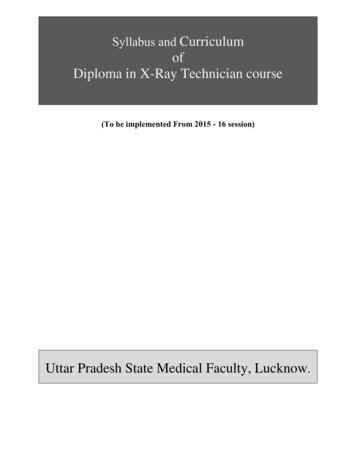
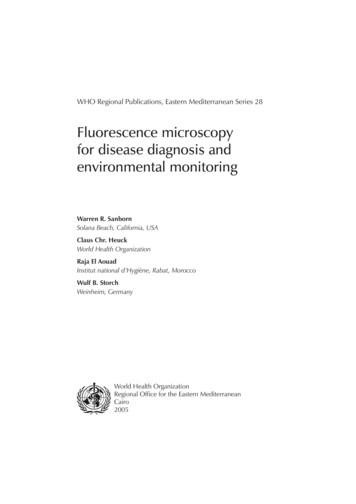
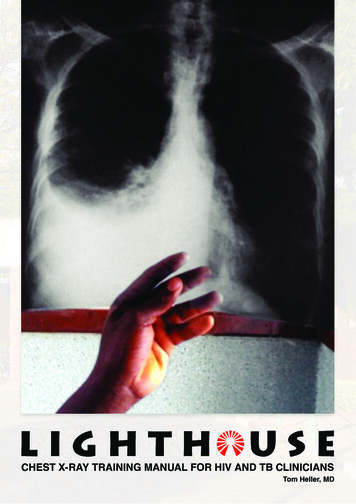
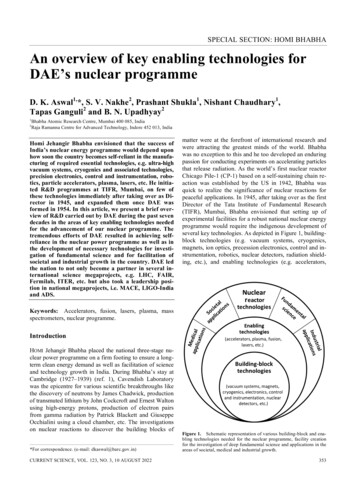
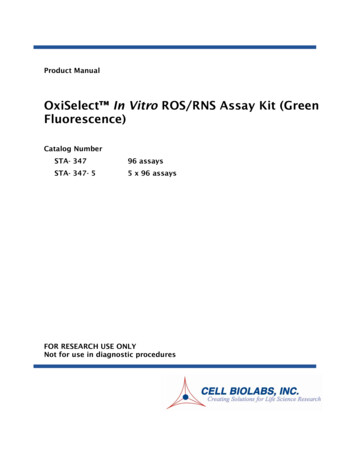
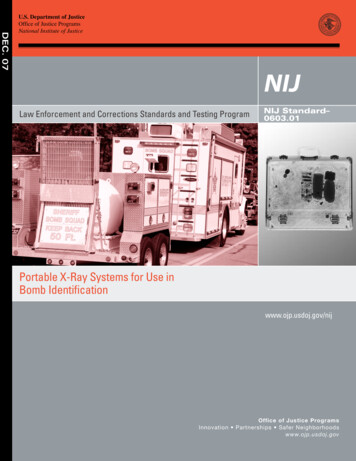
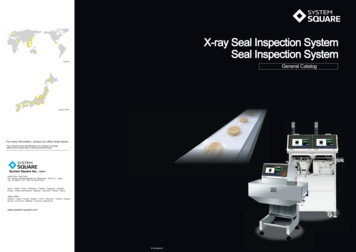
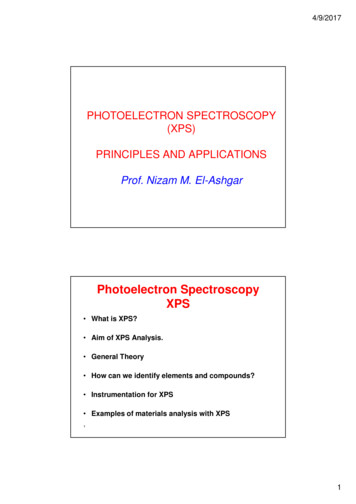
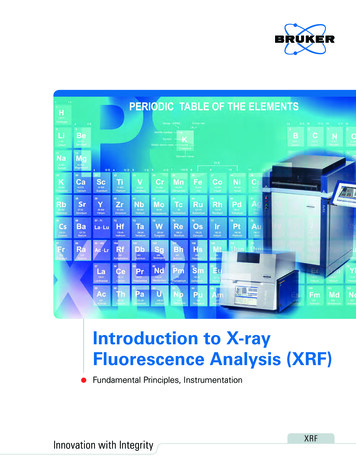
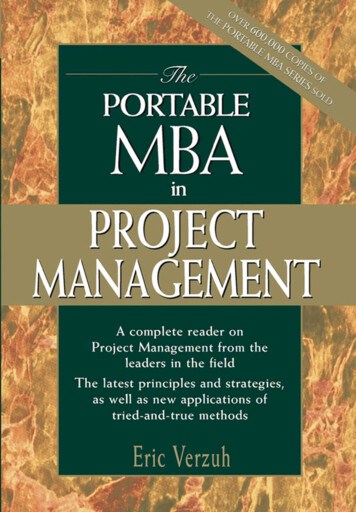
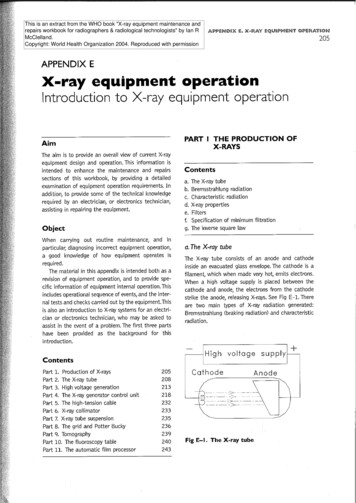
![[AWS Black Belt Online Seminar] AWS X-Ray](/img/17/20200526-blackbelt-x-ray.jpg)